TELL ME About It: AAC Learning with I Went Walking
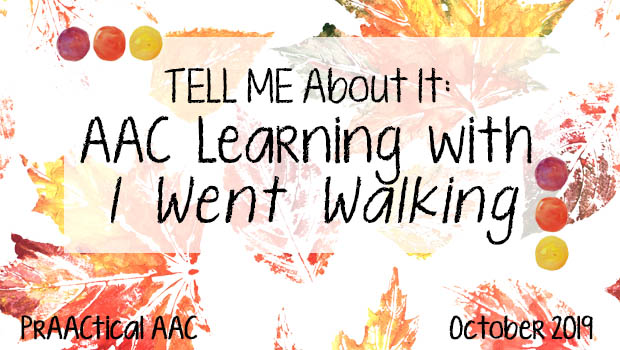
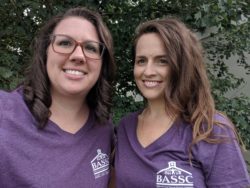
Jeanna Antrim and Maggie Judson are back with another installment of their series on implementing TELL ME in preschool classrooms. Each month, they share their tips and suggestions for helping classroom teams target core vocabulary with a different book. Maggie and Jeanna are speech-language pathologists who work in the Assistive Technology Department for the Belleville Area Special Services Cooperative (BASSC) in central Illinois. They are AT/AAC facilitators and provide evaluations, direct therapy, consultations, and trainings. In today’s post, Jeanna and Maggie share their ideas and experiences in target a set of core words with activities that focus on the book, I Went Walking.
Looking for the other posts in this series?
:::::::::::::::::::::::::::::::::::::::::::::::::::::::::::::::::::::::::::::::::::::::::::::::::::::::
TELL ME About It: AAC Learning with I Went Walking
TELL ME About Reading: The second book in the TELL ME program (Teaching Early Language and Literacy through Multimodal Expression) is “I Went Walking.” An excellent extension book from “Brown Bear, Brown Bear” as it continues the exposure to the concept vocabulary of animals and colors. Great for getting repeated exposure to core words and familiar vocabulary in the context of a different book (repetition with variety!)! Also, check out that core word focus below. One of the main components of the TELL ME program is infusing core words throughout the school day in lots of activities. There are new focus words for this book, plus you’ll notice that we’ll be repeating the core words (SEE and YOU) from “Brown Bear, Brown Bear”. A great way to work on that all-important repeated exposure!
Book Focus: I Went Walking
- Core Words (BOW WOW Words): I, See, What, You
- Additional Words (Tiger Talk Words): Front, Read, Tell
- Concept Vocabulary: colors and animals
- Special Letter: s
- Book Concept: front of the book
TELL ME About Writing: Students should enter school having had a lot of experience with early, emergent writing opportunities. Experimenting with crayons and pencils, scribbling, drawing pictures to tell a story, stringing different letters together to “write” a sentence. But, students with complex communication needs may not get these same types of early writing experiences. So, it is up to us to provide our students in the preschool and early childhood special education classrooms with these early writing opportunities and experiences! Early writing exposure and instruction are so powerful because writing development has an impact on the overall language and literacy learning for students!
Identify letters, labeling letters, and copying words from a model may be common starting places to address writing instruction. But going beyond that to write for authentic reasons is a core principle of the TELL ME program. It provides an excellent platform of activities and instructional practices to enhance the writing instruction we implement in our classrooms and therapy rooms.
One easy, natural way to bring in those authentic writing opportunities could be to go on a walk to find words that start with the special letter “s”! Write them in the letter book included in the TELL ME manual or on a letter board and then read, talk, and write about the items found that started with the letter “s.” 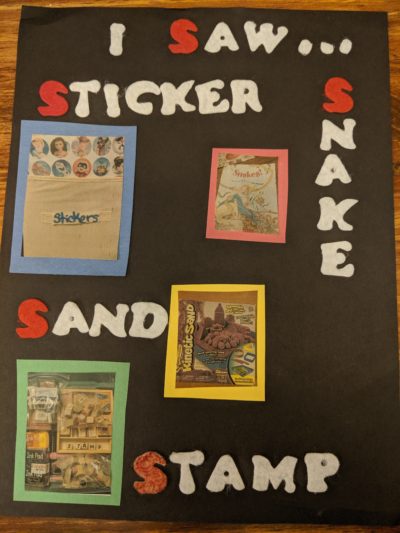
TELL ME More: Below are some specific ideas on how to implement “I Went Walking” in your therapy sessions and classrooms TELL ME-style!
Activity – Picture Walk!
Reading pictures is reading! And this activity presents another opportunity to hit those core words – I, SEE, WHAT, YOU!
A picture walk is a simple activity that you do before ever reading the book! It is a quick activity done for two days/sessions and is crucial for accessing and activating students’ background knowledge, introducing vocabulary words, and working in those target core words. It is also a time for students to focus on the pictures in the book and ask questions. That way, during the actual reading process, they can be more focused on the text and story elements!
During a picture walkthrough, we like to review the focus book concept, which for this book is the cover. You point to the pictures on the front cover and ask the student to make predictions for the story. Then flip through each page of the book, look at the illustrations, and make comments and ask questions. Some examples of comments and questions you could say are:
- “I wonder” sentences… “I wonder WHAT this story is about?”, “I wonder WHAT will happen in our story”, “I wonder WHAT will happen next?”
- “Look, I SEE Do YOU?”
- “I SEE a shirt.”
- “I have a dog at home. Do YOU?”
- “Let’s SEE what animal is next.”
And don’t forget – this should be a super fun and engaging activity! Relate the book and the pictures to the students’ own experiences! You can make statements like: “SEE all the animals walking? Who likes to go on walks?”, “Do YOU ever SEE animals on a walk?”, and talk about who they go with, WHAT they SEE, and how they feel about taking walks.
Teaching Strategy – Aided Language Input!
- What is Aided Language Input: It is an instructional strategy used to teach symbol location, symbol meaning, and symbol use. In a nutshell, it is talking in symbols! The purpose is to use symbols paired with speech to help guide and support AAC users to learn the location of words on their AAC system, what those words mean, and how to use them. Think of it as talking in AAC. The purpose is to show how to communicate using symbols. And you will find yourself using the students’ AAC systems as much as, or even more than they do, as you provide this aided language immersion!
- Why It Is Important: When discussing the importance of aided language input, we love this quote from Carole Zangari: “Aided language input, the practice of modeling AAC when speaking to those who are trying to learn AAC, is a pivotal intervention strategy. It has been shown to support comprehension and expression, and the development of early sentence forms.” (https://praacticalaac.org/praactical/research-support-for-aided-language-input/)
For students to learn what words mean, how to use words, and the location of words on an AAC system, students need to be immersed in aided language learning. Focusing on providing this immersion through aided language input for a set of target words each week makes this language learning manageable and doable!
- Providing Aided Language Input During Reading: This is the easy-peasy part! Each time you come across one of the target core words – I, SEE, WHAT, YOU – in the text of the book, touch the symbol for that word on the manual communication board as you say it. When you make comments and ask questions during the shared reading interaction, work in those target core words – I, SEE, WHAT, YOU – and touch the symbol of that word on the manual communication board as you say it!
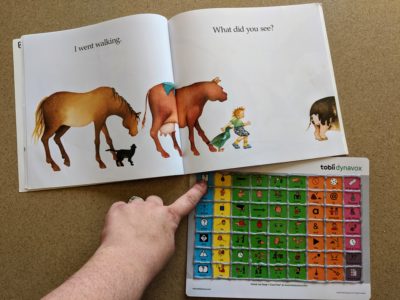
- How To Provide Aided Language Input Throughout The Day: A great way to work this powerful teaching strategy into the school day is to provide aided language input for the target core words – I, SEE, WHAT, YOU. Having a set of core words to focus on gives direction for all communication partners in the classroom.
Here are some examples to incorporate aided language input for the target words in different activities:
- Arrival time: “I am so happy to SEE YOU!”, “I SEE YOU have your backpack”, “WHAT did YOU do last night?”
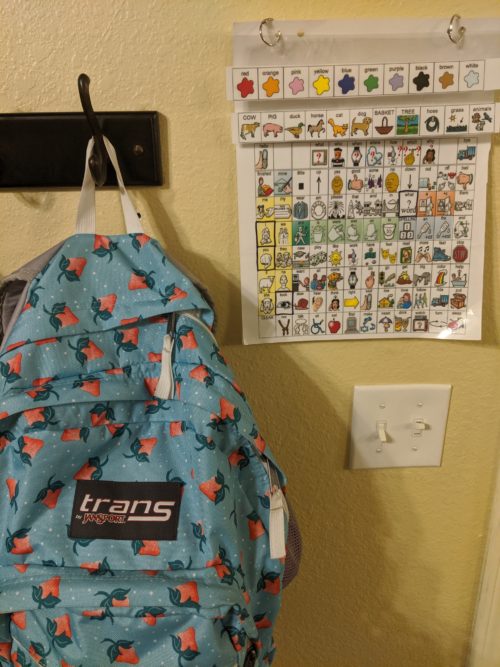
- Circle time: “I wonder WHAT we will read today?”, “WHAT is the weather like today?”, “YOU can look out the window and SEE!”

- Centers: “WHAT do YOU want to play with?”, “I SEE lots of fun toys!”, “I want to read with YOU”
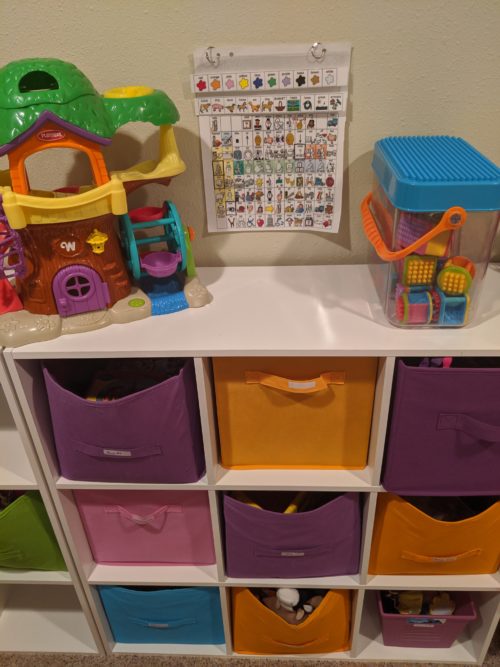
- Snack time: “WHAT do YOU want to eat?”, “Let’s SEE WHAT we have for snack.”, “I SEE that YOU like that!”
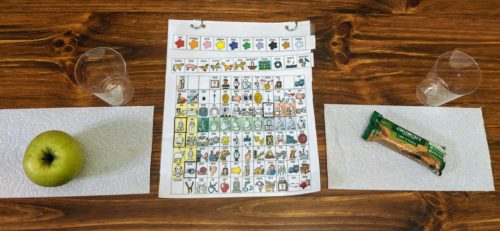
- Outdoor time: “WHAT will we play outside?”, “I SEE the slide.”, “WHAT do YOU want to do?”, “I SEE YOU shaking your head, YOU don’t want that.”
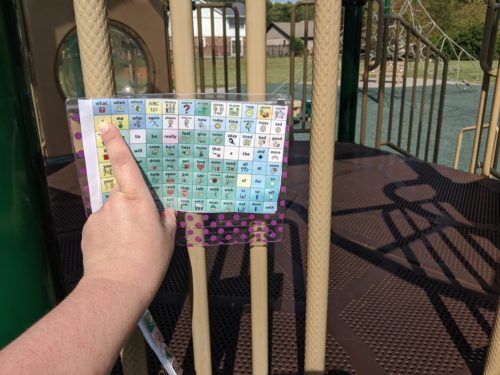
Implementation Tip – How to support staff and aides to implement TELL ME!
- Access: One of the first steps to implementing a TELL ME week is to have access to AAC systems throughout the school environment. Without easy access to manual communication boards and other visual communication supports, it can be challenging for the communication partners to provide aided language input and work in the learning of those target core words – the main crux of the TELL ME program. So step one: get those manual communication boards set up throughout the classroom!
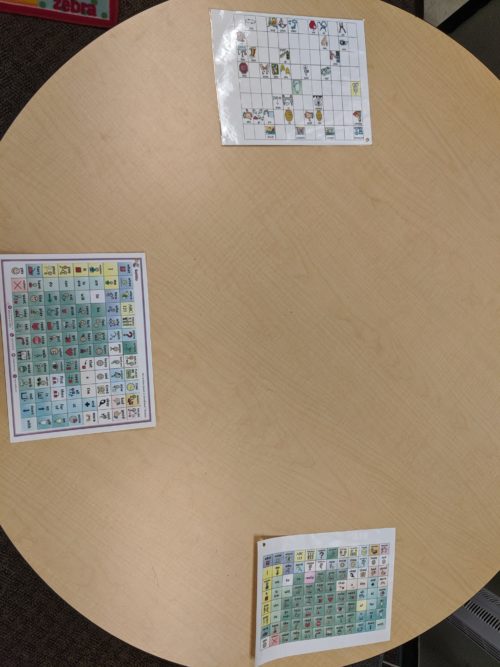
- Team Meeting: During your weekly team meeting, dedicate some time to talk, discuss, and brainstorm about TELL ME. This is a natural time to chat with staff about the focus for instruction for the week. Feel prepared by using a lesson planning sheet! Doing activities to get comfortable and familiar with the AAC systems and the location of words is an excellent way to get everyone on the same page! Take turns finding I, SEE, WHAT, YOU on the manual communication boards. Practice saying a few sentences that contain the words while touching them on the manual communication boards. Take a few minutes to read through the book “I Went Walking” as a group while practicing aided language input for the words I, SEE, WHAT, YOU. Practice makes progress!
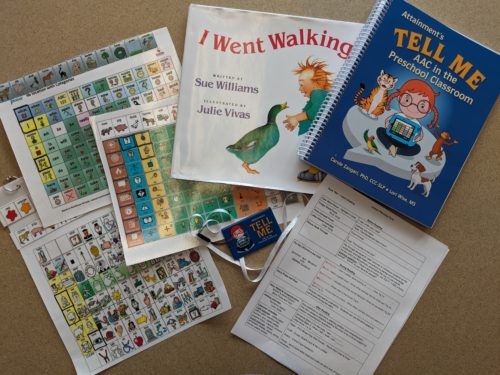
- Specific Visuals for Staff: Remember that adults need visuals, too! Without these reminders, it can be easy to forget the focus during the TELL ME activities.
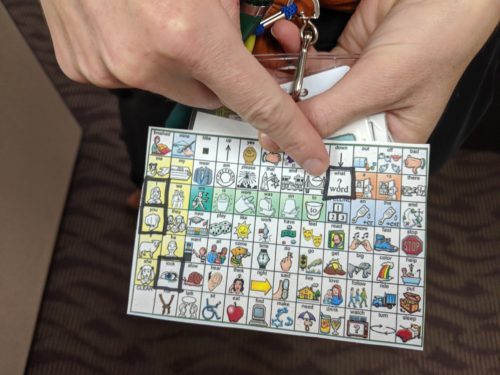
For example: We’ve all been there. You’re in the middle of a shared reading activity, but the students are wiggling around and not paying you much attention. You try and stay focused, but you get flustered. Somewhere in there, you forget which core words you wanted to target-Ugh! This has happened to us more than once, and we have learned from our mistakes! To help keep us focused, we have found it super helpful to highlight the target core words in the book. You can use either a highlighter, sticky note, or highlighting tape to do this – anything that will make it easy to see what words to focus on – I, See, What, You – even when things get distracting! Anyone picking up the book will see what core words to focus on and emphasize! 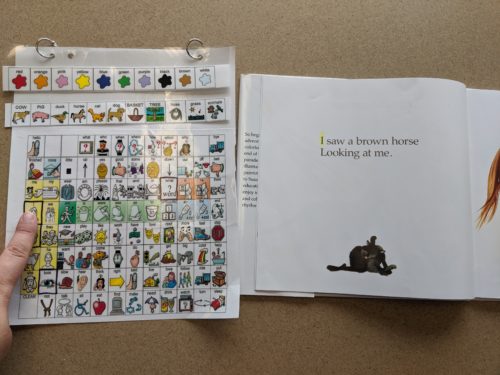
Other ways to incorporate support for classroom staff to implement a TELL ME week:
- Post the focus core words in a central spot in the classroom so that everyone can easily be reminded of the words
- Include a little cheat sheet of the focus concepts on lanyards
- Put a sticky note reminder on data sheets to keep that core word game strong during different activities during the school day
- Highlight the core words I, SEE, WHAT, YOU on the manual communication boards to make it easy to see and find the target words
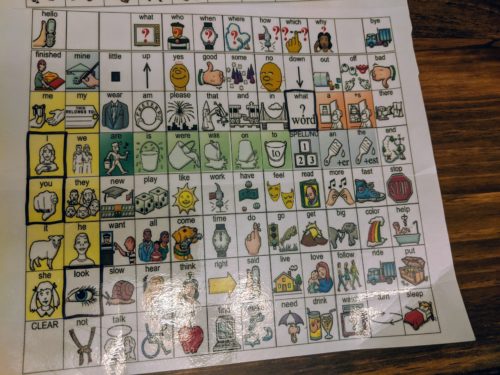
- Provide staff with verbal reminders to incorporate those core words – I, SEE, WHAT, YOU – as they are going about the day
- Example: “Remember, you can work on the core words while you are walking with students in the hallway by saying ‘YOU are walking. WHAT DO YOU SEE?’.”
To read more about how we prepare for a TELL ME book and incorporate visuals to support classroom staff, check out our previous posts, TELL ME About It: AAC Literacy Kits and TELL ME About It: AAC Learning with Brown Bear, Brown Bear
- Goal Idea – Providing shared reading and writing opportunities directly relates to IEP goals, as these activities align with various core standards. Here are some examples you may find applicable:
- ELA-Literacy.W.K.2:Use a combination of drawing, dictating, and writing to compose informative/explanatory texts in which they name what they are writing about and supply some information about the topic.
- ELA-Literacy.W.K.1:Use a combination of drawing, dictating, and writing to compose opinion pieces in which they tell a reader the topic or the name of the book they are writing about and state an opinion or preference about the topic or book (e.g., My favorite book is . . .).
Be sure to check back next month as we work through the TELL ME manual and share activities, teaching strategies and implementation tips for the next book in the program, “From Head to Toe”!
You can purchase the TELL ME manual from the Attainment Company (www.attainmentcompany.com/) or from ASHA (bit.ly/2XF1w1r ).
You can learn more about the program by watching the webinar TELL ME: AAC for the Preschool Classroom presented by Dr. Carole Zangari, available from Saltillo (bit.ly/2RNpykn).
You can find our Lesson Plan and template for “I Went Walking” here.
Check out the videos of us reading the book “I Went Walking” while providing aided language stimulation for the target core words –https://youtu.be/w-l9ICZmZbk
Follow us on Instagram @basscAAC and subscribe to our YouTube channel (basscAAC) for more AAC implementation ideas!
Filed under: Featured Posts, PrAACtical Thinking
Tagged With: preschool, TELL ME
This post was written by Carole Zangari


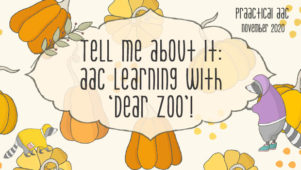
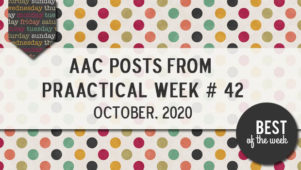
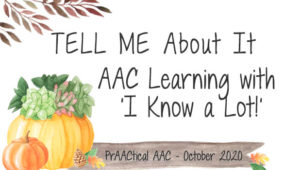
1 Comment
I love this kit. I love the multiple boards for instruction that are easy to access and time isn’t wasted searching and moving between EEG pages. How can one be purchased?